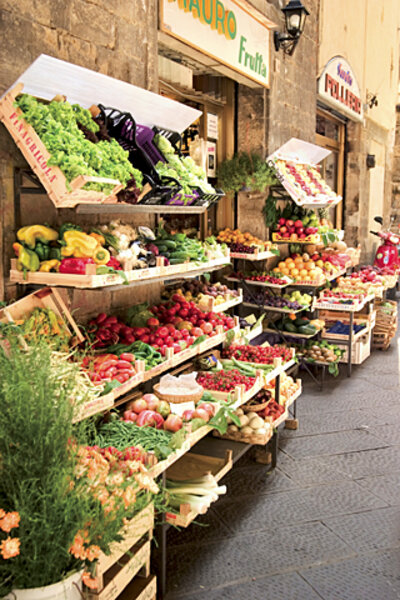Italy's frutta heaven
As someone who travels frequently for both business and pleasure, I'm quite aware of how easy it is to find junk food on the road and how it takes a little extra effort to find whole plant-based foods. One of my favorite places to experience the latter is Italy, whose native cuisine abounds in fresh produce and favors olive oil over butter.
One of the most wonderful aspects of eating vegan in Italy is that, because every ingredient that goes into a dish is valued, restaurant menus provide a description of exactly what the dish entails – and honor it. For example, under the title "White Beans in Tomato Sauce," it might read (in Italian, of course): "beans, olive oil, tomatoes, garlic, and basil." Under bruschetta, it might say "tomatoes, olive oil, garlic, and salt." And that's exactly what you get, as opposed to in the United States, where dairy-based cheese is automatically added to everything you order, even if it doesn't say so on the menu.
In Italy, when I order something like "White Beans in Tomato Sauce" and say, "No formaggio, vero?" ("No cheese, right?"), the waiter will often look at me as though I have three heads, as if to say, "Does it say 'formaggio' on the menu? Then why would you ask?" Amazing.
The cuisine is so localized that menus change from one region to the next. In Tuscany and Umbria, I enjoyed panini featuring roasted vegetables (red peppers, eggplant, tomatoes, and red onions) with olive oil and balsamic vinegar between two pieces of salty, hot focaccia. For dessert, I reveled in a traditional Siennese dessert called panforte, a delicious amalgam of dried fruit, nuts, and sugar.
In Florence, I couldn't get enough garlicky white beans with olive oil, spicy penne arrabbiata, green salad with artichokes, and macedonia di frutta – a simple fruit salad sold by many street vendors.
Farther south, pizza is a mainstay, and no one looks at you funny when you order a pie without cheese. After all, the oldest pizza in Italy is pizza marinara, which is just fresh tomato sauce and oregano atop a thin crust. Granita, a fruit-based frozen dessert, which originated in Sicily, can be found all over Italy.
No matter where you are, a traditional Italian menu consists of antipasti (appetizers), primi (first course), secondo (main dish), insalate (salads), pizza, and contorni (side dishes). Of them, only the main dish tends to be meat- and dairy-heavy, so I rely on the other dishes, which – in addition to those named above – always include roasted seasonal vegetables, such as potatoes, asparagus, or peppers, and various vegetable-rich pasta dishes.
I think we forget that plant-based foods were once staples in the diets of people all around the world, so choosing the simple indigenous foods of the countries we're visiting means increasing the chances that they're vegan. All it takes is a simple question: No formaggio, carne, o burro vero? Si!
Farro is one of the ancient cereal crops of the Mediterranean region, along with wheat, spelt, and barley, which have enjoyed a resurgence in popularity, particularly in Italy. If you are unable to find farro, barley makes a fine substitute.
2 cups uncooked farro or barley
5 cups water or vegetable stock
1 cup diced bell pepper (a combo of red, yellow, and orange makes a beautiful presentation)
1 cup diced carrots (about 4 carrots)
1 cup diced cucumber, unpeeled
1 cup chopped scallions (about 6 scallions using both white and green parts)
1/2 to 3/4 cup toasted pine nuts
1/2 cup finely chopped parsley
1/2 cup finely chopped mint
1 to 2 tablespoons balsamic vinegar
1/4 to 1/3 cup olive oil
Juice of 1 or 2 small lemons
Salt and pepper, to taste
In a 3- or 4-quart saucepan, combine the farro and water or stock, and bring to a boil over high heat. Reduce heat to low, and simmer without stirring for 35 to 45 minutes, until the stock is absorbed. Remove from heat.
Meanwhile, in a large bowl, add the pepper, carrots, cucumber, scallions, pine nuts, parsley, and mint. Stir to combine. Add the vinegar, olive oil, the juice of one lemon, and salt and pepper, to taste. Add the cooked farro, taste, and add more lemon juice and salt, if necessary.
Serve right away or the next day.
Yield: 9 cups
(Reprinted from "Color Me Vegan," by Colleen Patrick-Goudreau.)





